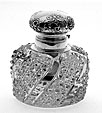American Cut Glass Authenticity
By Max Redden
At the 1989 ACGA Convention in New Orleans, I spoke about the number of new fake Cut Glass pieces that have been sold in the last 8 to 10 years. Since then, I have compiled a list of 40 known patterns that have been sold to many collectors all over the country.
Everyone of these pieces can be recognized by one of several methods. Since only a small portion of ACGA membership attends the Convention, I think everyone should be warned to be on the lookout for these fake pieces of glass, should they be offered for sale. There are still some very good pieces to be acquired, but you must be able to tell the difference.
There are five things to look for in a piece of old American Brilliant Period Glass: 1. Fluorescence; 2. Signature; 3. Shape of the Blank; 4. Wear Marks on the Bottom and Face of the Blank; and 5. Diamond Wheel Cutting.
1. Fluorescence -- Any of the new pieces pieces will show a Pink or Purple color when exposed to a 15 Watt Blacklight Blue Fluorescent Bulb in a dark room.
2. Signature -- The signature on the new pieces, if they are signed, is usually very poor or smudgy--looking when compared to the old signatures.
3. Shape of the Blank -- The shape of the blank is usually different from the old ones, especially the 7" plates. They are usually almost twice as thick and have a high spot in the center of the blank.
4. Wear Marks on the Bottom and Face of the Blank -- Be sure to look for wear marks on both the bottom and the inside of the piece, and look for damage, as most old pieces will have some small nicks or abrasions on the outer edge or bottom.
5. Diamond Wheel Cutting -- All of the new pieces have been cut with diamond wheels, which leave small grooves in the glass which can be detected if you look very closely. Most of the pieces are Acid Polished, which can be seen if you examine the piece very carefully. I have a piece of Libbey " Grand Prize" which was polished on a wood or felt wheel because Libbey didn’t use acid in their earlier years; however, this piece fluoresces Pink, is in a pristine condition, has a bad signature, and was cut on a diamond wheel. There are several mistakes in the pattern, which leads me to believe the cutter had never seen a real piece of "Grand Prize." I purchased this piece several years ago, before I was able to detect fake Cut Glass.
Following is a list of new pieces in named patterns that have been sold in the last 8 to 10 years:
Aberdeen -- Jewel
Alhambra -- Meriden
Byzantine -- Meriden
Theodora -- Meriden
Arabesque -- Hoare
Creosus -- Hoare
Wedding Ring -- Hoare
Wheat -- Hoare
Arabian -- Egginton
Calve -- Egginton
Cluster -- Egginton
Genoa -- Egginton
Persian -- Egginton
Russian - Egginton
Clover -- Hawkes
Concentric Circles -- Hawkes
Coronation -- Hawkes
Grecian -- Hawkes
Lattice & Rosettes -- Hawkes
Nautilus -- Hawkes
Panel -- Hawkes
Panel & Pillar -- Hawkes
Queens -- Hawkes
Columbia -- Libbey
Grand Prize -- Libbey
Imperial -- Libbey
Isabella -- Libbey
Kensington -- Libbey
Comet -- Libbey
Marcella -- Libbey
Drape (Morello) -- Libbey
Aztec -- Libbey
Assyrian -- Sinclaire
Du Barry -- Quaker City
Good Luck - Bergen
Quatrefoil & Rosettes -- Clark
Rex -- Tuthill
Shell -- Tuthill
Trellis -- Egginton
Jewel Center Hobstar -- Jewel
I have never seen or have been able to purchase a fake piece of Hawkes "Gravic," Sinclaire Engraved Glass, or Tuthill Engraved Glass, which leads me to believe the cutters never had the ability to do this type of work.
I am still doing intensive investigation and hope to apprehend the person or persons who cut these fake pieces of glass. A conservative guess would be that from 3 to 5 million dollars worth of this glass has been sold in the last 8 to 10 years. The next time you purchase an important piece of glass, be sure to ask your dealer where it came from. You are entitled to know the history of every piece you buy.
Back to articles index





